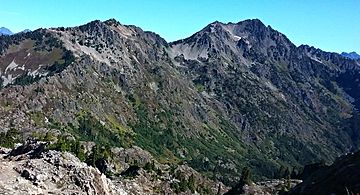Mount Henderson (Washington) facts for kids
Quick facts for kids Mount Henderson |
|
|---|---|

Mt. Henderson (left) and Mt. Skokomish (right) seen from the south at Mt. Gladys
|
|
| Highest point | |
| Elevation | 6,003 ft (1,830 m) |
| Prominence | 323 ft (98 m) |
| Parent peak | Mount Skokomish (6,434 ft) |
| Geography | |
| Location | Mason County, Washington, United States |
| Parent range | Olympic Mountains |
| Topo map | USGS Mount Skokomish |
| Geology | |
| Age of rock | Eocene |
| Climbing | |
| Easiest route | Hiking via Mt. Gladys |
Mount Henderson is a mountain in Washington state. It stands 6,003 feet (1,830 meters) tall. This peak is part of the Olympic Mountains in Mason County.
The mountain sits right on the edge of Olympic National Park. It also borders the Mount Skokomish Wilderness. Its taller neighbor, Mount Skokomish, is less than a mile away to the east. Rain and snowmelt from Mount Henderson flow into the Hamma Hamma River and Skokomish River. The mountain is named after Louis Forniquet Henderson (1853-1942). He was a botanist and mountaineer who explored the Olympic Mountains in 1890.
Contents
Weather and Climate
Mount Henderson is in a "marine west coast" climate zone. This means it's near the Pacific Ocean and gets a lot of moisture. Most weather systems come from the Pacific Ocean. They travel northeast towards the Olympic Mountains.
How Mountains Affect Weather
When these weather systems hit the tall Olympic peaks, they are forced upwards. This causes them to drop their moisture as rain or snow. This process is called Orographic lift. Because of this, the Olympic Mountains get a lot of rain and snow. This is especially true during the winter months.
Seasonal Weather Patterns
In winter, the weather is often cloudy. But in summer, high pressure systems over the Pacific Ocean bring clear skies. This means there's often little or no cloud cover. The snow here tends to be wet and heavy. This can sometimes lead to avalanche danger.
Mountain Building and Rocks
The Olympic Mountains are made of special kinds of rock. These rocks were formed from material pushed up from the ocean floor. This process is called obduction.
What Are the Rocks Made Of?
The main rocks are sandstone, turbidite, and basalt. Sandstone is made from tiny grains of sand. Turbidite forms from underwater landslides. Basalt is a type of volcanic rock. These rocks mostly formed during the Eocene epoch, which was about 56 to 34 million years ago.
How Glaciers Shaped the Mountains
During the Pleistocene era, huge glaciers covered much of the Earth. These glaciers moved across the land many times. As they advanced and retreated, they carved and shaped the mountains. This erosion created the rugged peaks and valleys we see today.



